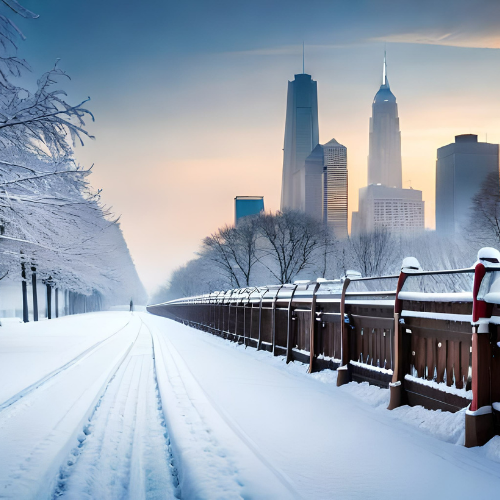
As the days grow shorter and temperatures drop, it's time for commercial property owners and managers to start thinking about winterization. Preparing a commercial property for the winter season isn't just about aesthetics; it's a crucial step in safeguarding your investment, protecting occupants, and maintaining business operations. The winter season presents unique challenges and hazards for commercial properties. The importance of having a comprehensive winter safety checklist cannot be overstated, as it serves as a critical tool in ensuring the safety, well-being, and operational continuity of businesses during the colder months. From managing snow and ice to preventing structural damage, maintaining heating systems, and safeguarding against fire and security risks, a well-prepared winter safety checklist is essential in mitigating the potential risks and liabilities associated with the season.

The Importance of Winterization
Commercial properties are substantial investments, and they need to be safeguarded against the harsh winter elements. Snow, ice, and freezing temperatures can lead to structural damage, roofing issues, and other costly problems. By winterizing your property, you can prevent these issues and extend the life of your building.
Safety should always be a top priority for commercial property owners. Slippery walkways, freezing indoor temperatures, and potential fire hazards are all risks during the winter season. Proper winterization measures can reduce these risks and create a safer environment for employees, customers, and visitors. The winter season doesn't just affect the building; it can also disrupt your business operations. Heating system failures, burst pipes, and power outages can lead to downtime and financial losses. By proactively winterizing your property, you can minimize the risk of these interruptions and keep your business running smoothly.
A Comprehensive Guide to Winterizing Commercial Properties
Now that we understand why winterization is important, let's delve into the practical steps to prepare your property for the cold months. Here is a comprehensive checklist to help you prepare your commercial property for winter:
Preventive Maintenance: Regularly inspect the property for potential hazards and address them promptly.Safety should always be a top priority for both employees and visitors.
Insulation & Weatherproofing: Check for gaps in windows, doors, and walls. Seal them to prevent drafts and insulate exposed pipes to prevent freezing. Know the location of shut-off valves in case of emergencies.
Roof & Gutter Maintenance: Inspect the roof for damage, leaks, and loose shingles.Ensure proper insulation and ventilation to avoid roof damage from snow and ice accumulation. Clean gutters and downspouts to prevent ice dams.
Exterior Maintenance: Trim overhanging branches to prevent damage from heavy snow and ice.Check for damaged or dead trees that may pose a risk during winter storms.
Exterior Lighting: Ensure all exterior lighting is working correctly to improve visibility in low-light conditions.
Consider installing motion-activated lighting for added security.
Vehicle Safety: Implement a safe parking policy during winter storms. Ensure company vehicles have proper winter tires and are regularly inspected.
Snow & Ice Removal: Arrange for a snow removal service to clear parking lots, driveways, and walkways.Stock up on salt or ice melt for immediate use.Ensure clear pathways to and from the building, including entrances and emergency exits.
Salting: Keep a stockpile of rock salt or ice melt for immediate use.Regularly apply salt to icy areas, paying particular attention to high-traffic zones.
Building Entry & Exit Safety: Place absorbent mats near entrances to prevent water and slush from being tracked inside.Provide slip-resistant flooring inside the building.
HVAC System Maintenance: Schedule a professional inspection of your heating system. Ensure it's in good working condition and replace air filters as needed. Replace air filters and clean ducts as needed. Set thermostats to maintain a comfortable indoor temperature.
Backup Power: Check and maintain backup power systems, such as generators, to ensure they function in case of power outages.
Fire Safety: Inspect and maintain fire suppression systems, including sprinklers and extinguishers. Ensure clear access to fire hydrants and emergency exits.
Security Measures: Review and update security protocols to address specific winter risks.Monitor surveillance cameras for suspicious activity, as winter can present unique security challenges.
Employee Training: Conduct winter safety training sessions for employees to educate them on safe practices during cold weather.Emphasize the importance of personal protective equipment (PPE) and proper clothing for outdoor work.
Emergency Supplies: Stock emergency kits with blankets, flashlights, and first-aid supplies.Ensure employees know the location of emergency supplies.
Emergency Communication Plan: Develop and distribute a communication plan for employees, tenants, and visitors, informing them of winter safety measures, such as parking rules, entrance locations, and emergency procedures in case of extreme weather events.Establish a chain of command for decision-making during winter emergencies.
By following this winterization checklist, you can help ensure the safety, comfort, and continuity of your commercial property during the winter season. Winterization isn't just about preventing problems; it's about providing the well-being of everyone on the property and maintaining the integrity of your investment. So, as winter approaches, take the necessary steps to prepare your commercial property and reap the benefits of a safe and productive winter season.
Have A Plan Ready BEFORE Winter Hits. Call ServiceMaster Recovery Management Today at 1-844-993-0527.

